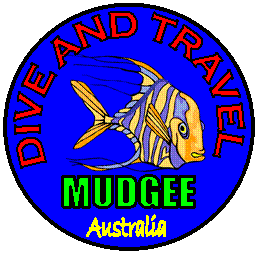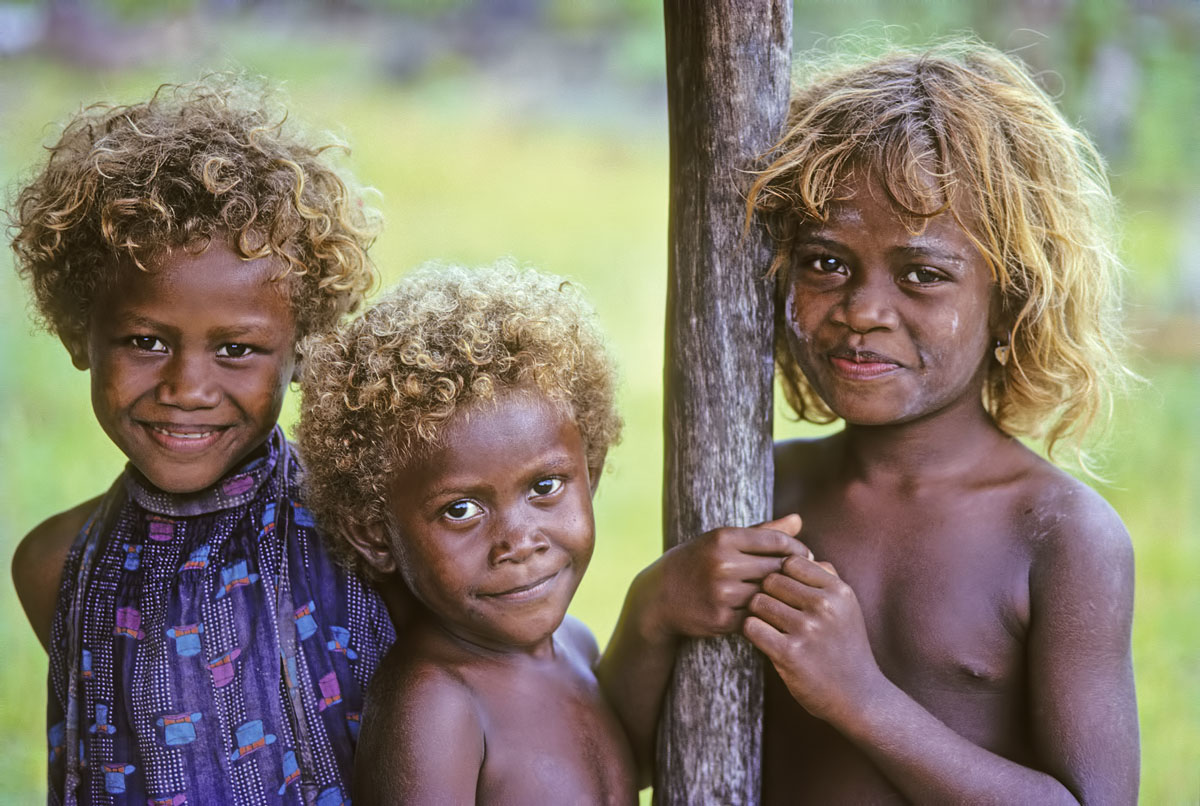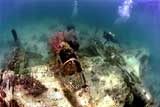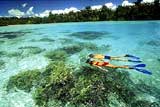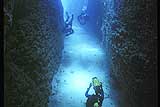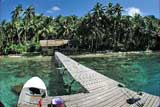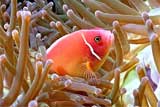
|
|
|
 |
||||||||||||||||||||||||||||||||||||
|
|
||||||||||||||||||||||||||||||||||||||
|
|
Gizo Island
Toa Maru:
A 135m Japanese ship lying on her starboard side. Sitting in 10-37m of water, this dive site is worth several visits as you can explore the ship's holds containing ammunition, saki bottles and even a two-man tank.
Plum Pudding Island:
Historically interesting as the late U.S. President, John F Kennedy and his crew of the PT 109 were shipwrecked here.
Grand Central Station:
If its underwater action you need then this is the place. The most north-western tip of the Gizo islands is the merge point for oceanic currents and its here where the fish life, big and small, is at it's best. Large soft corals and fans adorn the walls while sharks; trevally and batfish patrol the waters. A relatively easy dive for all levels of experience and there is no need to go deep to see all the activity.
Hot Spot:
This small pinnacle, one of our discoveries in 1995, comes up to 5m from the oceans depths of 300-400m. On the swing of the tide, pelagic's come into feed on the shoals of bait fish that congregate in and around this off-shore dive site. It is also the home of the most interesting pink iridescent anemone.
American Corsair Fighter Plane:
The pilot of this plane crashed into the sea at great speed and the aircraft is in five recognisable large pieces around the 27-metre level. However the attraction is not only the wreck but also the fantastic marine life on or around it. The reef slope back to the boat is interesting and has its own attraction in a bommie called clown fish city at the safety stop level.
Kennedy Wall:
A superb wall dive off the historic island where the late US President JFK and the crew of the PT109 swam to after being rammed by a Japanese destroyer. With excellent visibility, this wall, covered in a kaleidoscope of soft corals, dips down to 40m and hosts good pelagic action.
Olasana Reef:
A sloping reef dive revealing a vast array of hard and soft corals is a photographers dream. Famous for huge "elephant's ears sponges" and plentiful fish life, it also hosts several colonies of garden eels on its sandy bottom. Turtles are often seen, as Olasana Island is one of their resting sites.
Naru Gap:
At one of the entrances to Gizo lagoon, "The Gap" experiences great water flows with the changing of the tides. As a result, it has, most aptly, gained a reputation for BIG pelagic fish action
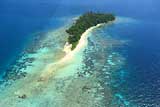
![]()
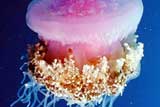
![]()
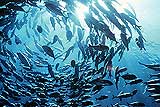
Honiara
Honiara is the capital of the Solomon Islands and of Guadalcanal Province.
Guadalcanal was witness to fierce naval battles during WWII and was a turning point in the Pacific campaign. "Iron Bottom Sound" is host to hundreds of wrecks.
Destroyers, minesweeper, troop carriers, transport ships, submarines and planes provide an incredible range of dive sites. Honiara, the nations' capital and international gateway, is the stopover point for travellers wishing to visit some of the land based WWII sites.
Honiara has a harbour from which ferries depart to the various provinces. The gardens of the National Art Gallery are popular, while the reconstructed Government House and the National Museum are worth visiting. The spectacular Tenaru falls can be found a one hour's drive and a three-hour hike from Henderson International Airport.
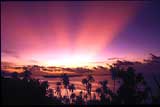
![]()
![]()
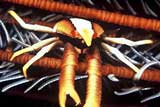
Tulagi
Located in the middle of the Solomon's, The Florida Islands offer some of the best diving to be found any where in the Pacific. The Islands are about 35 km north of Honiara across the famous Iron Bottom Sound.
Tulagi was the original capital of the Solomon's but was severely damaged during WWII and was replaced by the new capital, Honiara, after the war.
Several notable wrecks surround Tulaghi, as well as many interesting reefs and underwater features.
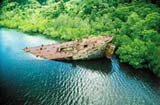
![]()
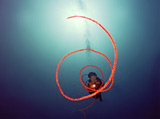
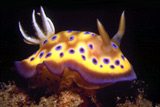
![]()
Uepi Island STAYED HERE IN MARCH 2013
 Uepi Island Resort is perched on the edge of the largest lagoon in the world. This area of the Western Province, offers opportunities for visitors to experience the culture of local people whilst relaxing in a tranquil environment.
Uepi Island Resort is perched on the edge of the largest lagoon in the world. This area of the Western Province, offers opportunities for visitors to experience the culture of local people whilst relaxing in a tranquil environment.
Uepi Island is approximately 2.5 km long and up to 600 metres wide, and the whole area, aside from the resort's cultivated tropical gardens, is covered with tropical rainforest interspersed with walking tracks.
Guests can participate in a variety of activities or simply relax. The lagoon side of the island has a sandy beach, with clear shallow water suitable for swimming, paddle and sail boarding, and canoeing. Uepi Resort is the only operation on this remote island.
There are no villages on the island. Guests can book at the Resort for trips to the nearby villages and rivers to enjoy the local culture and natural beauty.

![]()
![]()
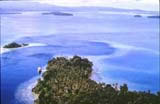
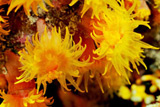
Uepi has magnificent reef diving. Dive sites vary from coral gardens with magnificent drop-offs, ledges and gutters featuring an enormous diversity of reef fish. Turtles, mantas and eagle rays are fairly common sights, as well as the (friendly) Uepi hammerheads.
Many of Uepi's dives are conveniently located within a 5 to 10 minute boat ride from the resort. Uepi also has some wreck diving. There are three wrecks lying in Wickham Harbour, all are Japanese freighters sunk by the US during World War 2. All are upright, relatively intact and display varying degrees of artefacts and marine life. All wreck dives are excursion dives and they are approximately one hour from Uepi by boat.



Uepi Island sits on the meeting place of several major currents, making it an excellent place for both drift dives and stationary dives, allowing you to watch the activity of the reef play out before you.
 When diving in Uepi, it's common for divers to stay in the water for an hour or so on each dive because the top 5-10 metres have endless species to discover, allowing a diver to get maximum value from each dive. Rarely will you view such high concentrations of fish, sponges and corals in such a diverse environment, ranging from coral gardens to vertical drop-offs into 2000 metres of ocean, most within the confines of a three kilometre reef. Water clarity is usually very good and water temperature is about 28−30 °C.
When diving in Uepi, it's common for divers to stay in the water for an hour or so on each dive because the top 5-10 metres have endless species to discover, allowing a diver to get maximum value from each dive. Rarely will you view such high concentrations of fish, sponges and corals in such a diverse environment, ranging from coral gardens to vertical drop-offs into 2000 metres of ocean, most within the confines of a three kilometre reef. Water clarity is usually very good and water temperature is about 28−30 °C.
![]()
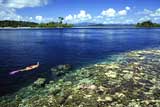
Solomon Islands Travel Tips
Time Zone: Solomon Islands Standard Time is 11 hours ahead of Greenwich Mean Time (this is 1 hour ahead of Australian EST).
Currency: Solomon Island Dollar. Australian dollars are accepted at most major resorts catering to Australian visitors. Credit Cards are accepted in some resorts. Carrying some cash is advisable.
Health: Visitors are strongly recommended to take a course of anti-malaria medication. See your doctor for advice and prescription. It is also advisable to take a personal first- aid kit. It is not recommended to drink the local water. Bottled water is available.
Visa Requirements: For most nationalities a visa is not necessary, a 30-day visitors permit is issued on arrival. However, all visitors must have a current passport, return or onward ticket and adequate funds to support the duration of their stay.
Departure Tax: SBD$40.00 departure tax (approx. AUD10.00) payable upon departure.
Electricity: Where available, 240 volts. 50 cycle A.C.
Tipping: Not encouraged. Visitors to the Solomons are usually asked to refrain.
Language: The predominant language is English.
Dress: Light casual clothing, not too brief especially outside your hotel.
Climate: Average daytime temperatures of 26-33 degrees Celsius, down to 22-30 degrees Celsius at night. The southeast trade winds blow from April to October. This time of the year is characterised by fine, dry weather. December to March is the "wet" season - the northwest monsoon. These months are warmer, more humid and experience the occasional tropical shower.
Water Temp: Generally ranges from 27-31 degrees Celsius.
MUDGEE DIVE & TRAVEL: THE PREMIER CHOICE FOR DISCERNING DIVERS AND TRAVELERS.
Site Design: Grant Willetts (MD&T)
Ph: 02 6372 1023; M: 0421 277 300; International: 61 2 6372 1023 ABN 98 124 932 154
All images, logos and trademarks are copyright of their respective owners. © Copyright 2005-2014. All Rights Reserved
Disclaimer: Data and information is provided for informational purposes only, and is not intended for any other commercial or non-commercial purposes. Neither us nor any of our data or content providers shall be liable for any errors or delays in the content, or for any actions taken in reliance thereon. By accessing our web site, a user agrees not to redistribute the information found therein. We provide customized links to select companies for your convenience only. We do not endorse or recommend the services of any company. The company you select is solely responsible for its services to you, the user. We shall not be liable for any damages or costs of any type arising out of or in any way connected with your use of our services.
| Site Map |
